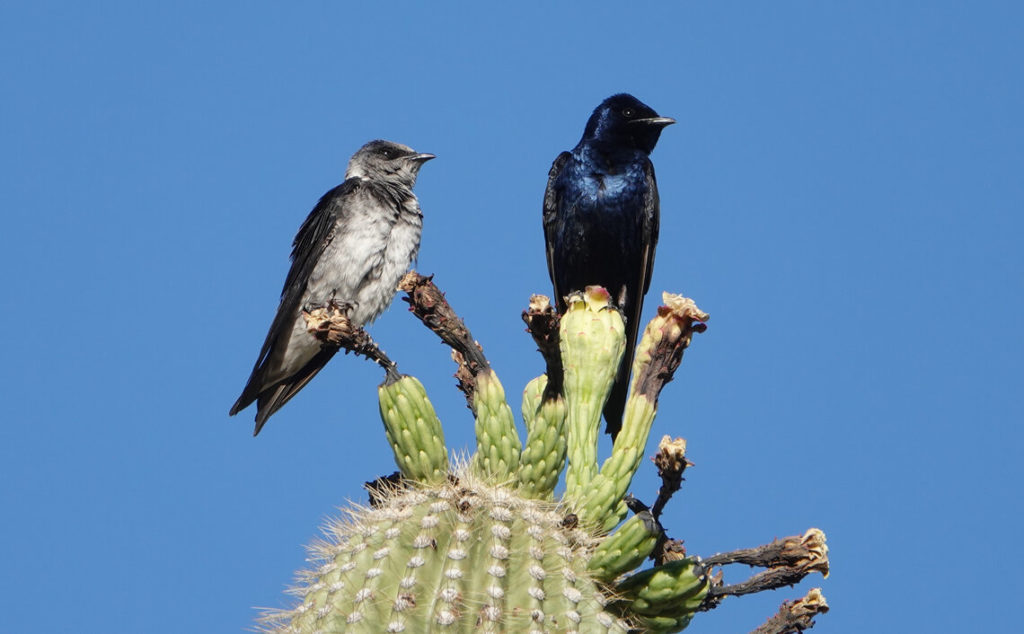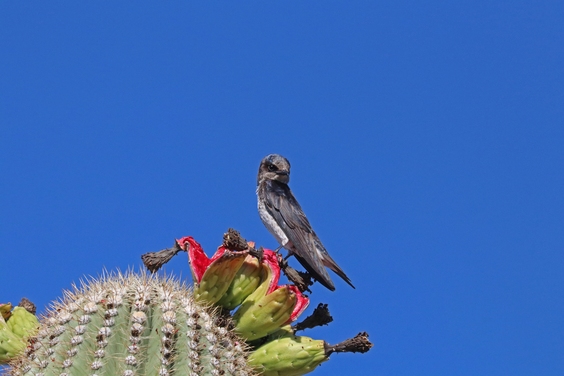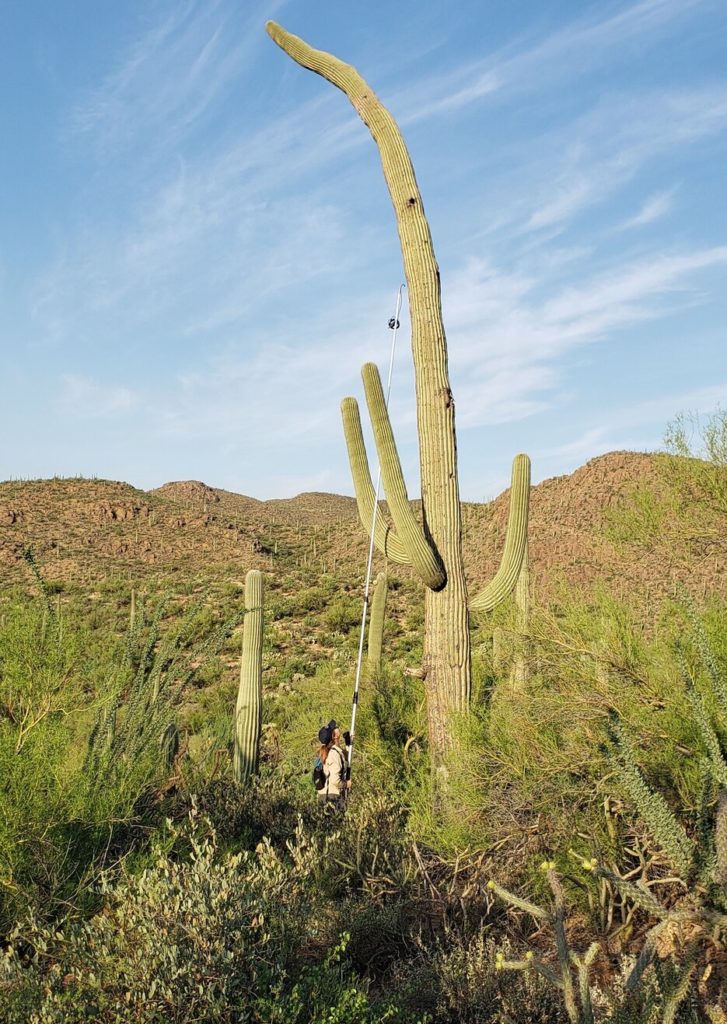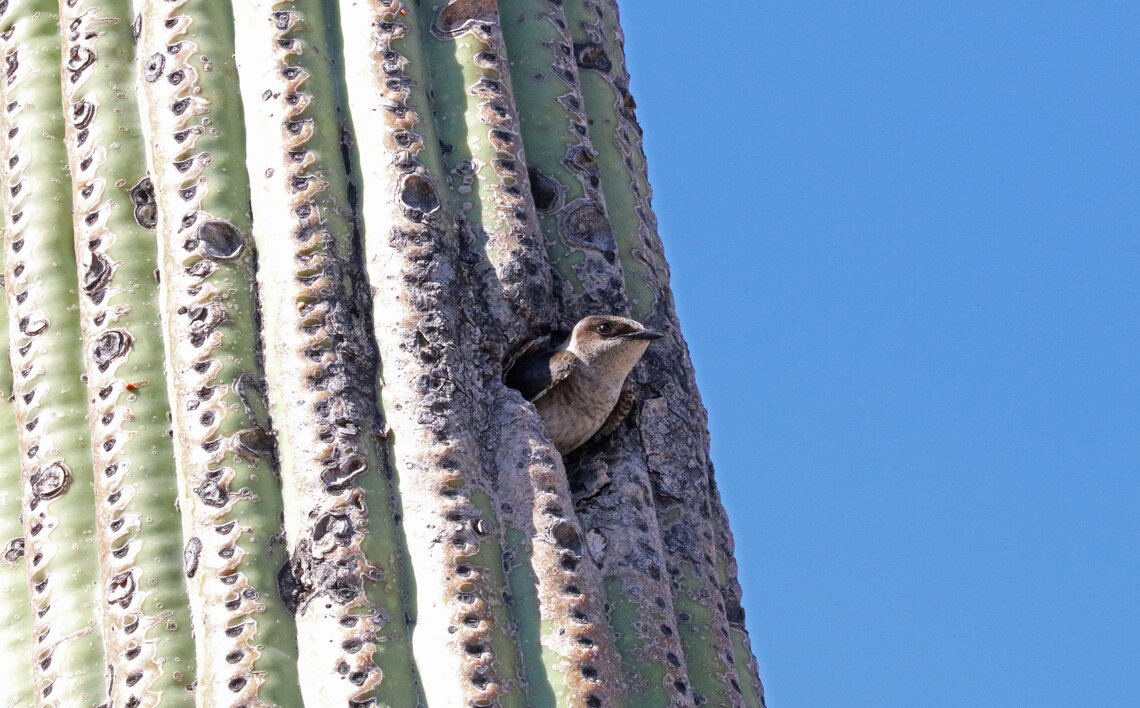By Emily Clark, Sonoran Joint Venture, in collaboration with Jennie MacFarland and Olya Phillips, Tucson Audubon Society
Some species of birds are so charismatic that they seem to capture the hearts of everyone. With the striking dark blue/purple iridescence of the male’s feathers, to their endearing vocalizations and insect-catching aerial acrobatics, the Purple Martin (Progne subis), exemplifies this category. The practice of putting up nesting boxes for the species is well documented over the course of history. From a single gourd, to impressive multi-unit complexes, people’s love for offering housing has significantly helped offset declines in available nesting cavities due to habitat loss across the eastern U.S. There are three North American subspecies: subis for the widespread eastern population, arboricola for western, high elevation forest nesting birds, and hesperia for the southwest desert nesting subspecies. While extensively studied in most of their breeding range, there is much to learn about the hesperia subspecies (hereafter Desert Purple Martin).

Unlike their eastern counterparts, Desert Purple Martin haven’t been documented utilizing artificial nest boxes, and are almost exclusively tied to columnar cacti (saguaro and cardon) nesting cavities. They are smaller and females are much paler in color. While all Purple Martins migrate to South America for the winter, Desert Purple Martin utilize different movement and timing strategies. They arrive later than other subspecies and take advantage of insect abundance during the monsoon season. At the end of the nesting season, birds gather in big communal roosts.
Jennie MacFarland, Tucson Audubon Society (TAS) Bird Conservation Biologist, first became interested in Desert Purple Martin back in 2012. Birder reports began to circulate about large congregations roosting on power lines in the summer in southeastern Arizona. Intrigued, TAS decided to investigate. While conducting a driving census survey, they observed Desert Purple Martin roosting in the thousands along power lines. “It absolutely blew us away with how many there were,” MacFarland recalled of the survey.
Desert Purple Martin can be found in abundance in places where lush riparian zones like the San Pedro River area adjacent to Sonoran desert habitat. This abundance did not only catch the attention of TAS, but that of Dr. Kevin Fraser of University of Manitoba, who studies Purple Martins in general. In 2013, he traveled to southeast Arizona and teamed up with TAS to get a closer look at the scientifically mysterious hesperia subspecies of Purple Martin. The team was able to find the anticipated large numbers of Desert Purple Martins along the San Pedro River, but also had success in Sonoran Desert areas west of Tucson. At that time, Dr. Fraser was unable to return for a second year of research, but that partnership would lead to more investigations down the road on these amazing birds.

Fast forward to 2020, with many questions yet to be answered about the natural history of Desert Purple Martin, TAS help found the Purple Martin Working group along with Dr. Fraser. They initiated a pilot survey to begin to address these data gaps. Armed with many loyal community science volunteers, 2020 was the perfect time to conduct these socially distanced observations. MacFarland, along with Olya Phillips, TAS Citizen Science Coordinator, led the development of the project. The main objectives of the study are to encourage people to report their sightings of birds and nesting cavities to TAS or through eBird; document nesting colonies and physical characteristics of nest cavities (e.g. height and orientation); and to conduct behavioral observations during the breeding season.
Community Science volunteers could participate on different levels, from simply reporting a sighting, to committing to monitor a nesting site for the duration of the breeding season. With virtually hosted protocol trainings and access to online materials and reporting, special care was taken to adhere to public safety guidelines while minimizing disturbance to delicate desert habitat and nesting birds.

In addition, MacFarland and Phillips were able to visit select nesting cavities to survey with an endoscope. This is pretty much a long, tubular instrument with a digital camera connected with a smart phone for easy viewing of a tight space. Nesting cavities can be up 15ft or more, so the endoscope was attached to a very long pole and carefully maneuvered into place. This took a lot of skill and patience. They also collected specimens (feathers or deceased birds) for genetic analysis.
Over 40 volunteers participated in the Desert Purple Martin pilot season survey. They documented 63 nesting saguaros and discovered more than 30 additional nesting areas. Surveyors observed over 20 roosting locations. From about July through September, the team collected detailed observations of breeding behavior and other natural history observations. While the data are still being interpreted, it seems that the birds prefer high nesting cavities, require high quality Sonoran Desert habitat, and prefer to roost near riparian areas. These initial results are just the beginning of future studies and a greater understanding of how to conserve this unique bird.
Tucson Audubon Society could not have launched this project without the amazing help of birders who reported sightings and dedicated volunteers who recorded detailed observations. If you are interested in participating in next year’s survey or want learn more, please visit the website. You can also view a video of the pilot season summary results and this fun video montage of the birds in action!

